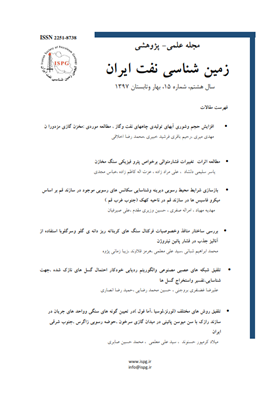بررسي ساختار منافذ و خصوصيات فرکتال سنگ هاي کربناته ريز دانهي گرو و سرگلو با استفاده از آناليز جذب در فشار پايين نيتروژن
محورهای موضوعی :سید علی معلمی 1 * , محمدابراهیم شبانی 2 , هرمز قلاوند 3 , زیبا زمانی پزوه 4
1 - پژوهشکده ازدیاد برداشت از مخازن نفت و گاز
2 - پژوهشگاه صنعت نفت
3 - شرکت ملی نفت ایران
4 - پژوهشگاه صنعت نفت
کلید واژه: خصوصيات ساختاري جذب در فشار پايين نيتروژن حجم منافذ بعد فرکتال شيل گازي گرو و سرگلو,
چکیده مقاله :
در اين مطالعه خصوصيات منافذ نمونههاي سنگهاي کربناته ريزدانه در ايران، برروي 9 نمونه برداشت شده از سازندهاي گرو (5 نمونه) و سرگلو (4 نمونه) با استفاده از روش جذب در فشار پايين نيتروژن مورد ارزيابي قرار گرفت. ميزان کل کربن آلي موجود در نمونههاي سازند گرو مابين wt% 64/0 تا wt% 21/5 (ميانگين wt% 2/3) و براي سازند سرگلو مابين wt% 12/0 تا wt% 94/10 (ميانگين wt% 3/4) متغير ميباشد. کاني کربناته بيشترين ميزان کاني (ميانگين wt% 64) موجود در نمونههاي مطالعه شده در هر دو سازند گرو و سرگلو را شامل ميشود. بعد از کربناتها، کوارتز (ميانگين wt% 15) و کانيهاي رسي(ميانگين wt% 9) قرار ميگيرند. حجم منافذ محاسبه شده مابين g100/3cm 6/0 و g100/3cm 5/2 با ميانگين g100/3cm 4/1 متغير است که مشابه تحقيقات انجام شده بروي شيلهاي گازي آمريکا ميباشد. يک رابطهي خطي ميان ميزان کربن آلي و خصوصيات منافذ براي نمونههاي هر دو سازند گرو و سرگلو مشاهده شد. به دليل تغييرات گستردهتر ميزان کل کربن آلي در سازند سرگلو نسبت به سازند گرو، اين رابطه خطي در سازند سرگلو مشهودتر ميباشد . بعد فرکتال بدست آمده براي نمونههاي مطالعه شده مابين 45/2 و 81/2 و با ميانگين 64/2 متغير است. مقادير نسبتا بالاي بعد فرکتال بدست آمده نمايانگر ميزان بالاي ناهمواري و پيچيدگي در سطوح منافذ نمونههاي شيلي گرو و سرگلو ميباشد. وجود رابطهي مستقيم ميان ميزان ماده آلي و بعد فرکتال را ميتوان به وجود ريزمنافذ در مواد آلي و در نتيجه ساختار ناهموار و پيچيده منافذ نسبت داد. براساس مشاهدات ميزان ماده آلي به عنوان مهمترين پارامتر کنترل کنندهي خصوصيات منافذ در نمونههاي سازند گرو و سرگلو معرفي شد.
The present paper tends to analyze the pore structure of Organic rich carbonaceous rock in 4 samples from Upper Jurassic Sargelu and 5 samples from Lower Cretaceous Garau formation using low pressure nitrogen adsorption. TOC content of Garau samples ranged between 0.64 wt% and 5.21 wt% (mean 3.2 wt%).TOC varied between 0.12 and 10.94 for Sargelu samples. XRD results shows that carbonates are the dominant minerals, followed by quartz and clay minerals. The calculated total pore volume vary between 0.6 cm3/100g to 2.5 cm3/100g with the mean values of 1.4 cm3/100g. A positive linear correlation were found between TOC content of measured samples with pore structure parameters. Due to the larger variation of TOC content this relationship was more obvious for the Sargelu samples. The calculated fractal dimension ranged between 2.45 and 2.81 emphasizing the irregular pore surface of the measured samples. Based on the result of this study organic matter content is recognized as a controlling factor for pore structure and fractal characteristics of the Garau and Sargelu samples.

